Australia's only active volcano
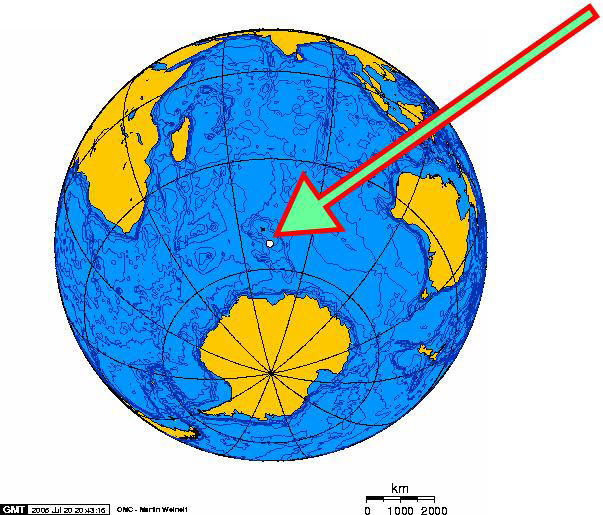 The Heard and McDonald Islands World Heritage Property was inscribed
on the
World Heritage List
in 1997 for its outstanding natural universal
values:
The Heard and McDonald Islands World Heritage Property was inscribed
on the
World Heritage List
in 1997 for its outstanding natural universal
values:
- as outstanding examples representing major stages of the earth's history, including the record of life, significant ongoing geological processes in the development of landforms, or significant geomorphic or physiographic features ; and
- as outstanding examples representing significant on-going ecological and biological processes.
The Australian Territory of Heard Island and McDonald Islands
(HIMI) lies in a remote and stormy part of the globe, near the
conspicuous meeting-point of Antarctic and temperate ocean
waters. The islands were unknown to humanity until the 19th
century. HIMI is an external territory of Australia in the
Indian Ocean sector of the Southern Ocean at around 53° 05' S
and 73° 30' E. The Territory lies about 1500 km north of Antarctica and
over 4000 km south-west of Australia.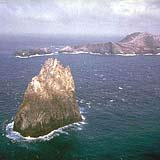
Heard Island (area 368 km2) is the principal island of HIMI. Mawson Peak, at 2745 m, is the summit of Big Ben, an active, towering volcano that dominates the group, with a thick mantle of snow and glacial ice contrasting black volcanic rocks in a startling array of forms and shapes. To put the height into perspective, Mt Kosciuszko is 2228 m high but that's not Australia's highest peak, if you include the Australian Antarctic Territories, where Mt McClintock reaches 3490 m.
McDonald Island (area 1 km2), 43.5 km due west of Heard Island, is the major island in the McDonald Islands group, which also includes Flat Island and Meyer Rock. At its highest point it rises to about 230 m. The McDonald Islands, also volcanic in origin and, like Heard Island, an undisturbed habitat for sub-Antarctic plants and animals, consists of two distinct parts joined by a narrow central isthmus.
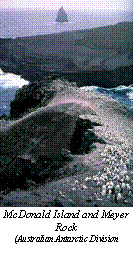 The HIMI group can be described as the wildest place on
earth-a smoking volcano under a burden of snow and glacial ice
rising above the world's stormiest waters. On the horizon to the
west, smaller volcanic fragments rise precipitously and
defiantly out of huge Southern Ocean swells. From a distance the
land is a striking monochrome-black rock and sand, white snow
and ice, leaden grey seas and skies. When the sun does appear
the islands light up in the clear air to a rare
brilliance-verdant vegetation and multi-coloured bird colonies
in sharp relief against the dazzling white of snow and ice and
the grey-black of volcanic rock. The elements-hurricane-force
winds, driving rain, vast amounts of snow, dense clouds and
fogs-conspire with the landforms to create a world of high drama
and savage beauty. The driving westerly winds above the Southern
Ocean in these latitudes create unique weather patterns when
they come up against the enormous bulk of Big Ben, including
spectacular cloud formations around the summit and unbelievably
rapid changes in winds, cloud cover and precipitation.
The HIMI group can be described as the wildest place on
earth-a smoking volcano under a burden of snow and glacial ice
rising above the world's stormiest waters. On the horizon to the
west, smaller volcanic fragments rise precipitously and
defiantly out of huge Southern Ocean swells. From a distance the
land is a striking monochrome-black rock and sand, white snow
and ice, leaden grey seas and skies. When the sun does appear
the islands light up in the clear air to a rare
brilliance-verdant vegetation and multi-coloured bird colonies
in sharp relief against the dazzling white of snow and ice and
the grey-black of volcanic rock. The elements-hurricane-force
winds, driving rain, vast amounts of snow, dense clouds and
fogs-conspire with the landforms to create a world of high drama
and savage beauty. The driving westerly winds above the Southern
Ocean in these latitudes create unique weather patterns when
they come up against the enormous bulk of Big Ben, including
spectacular cloud formations around the summit and unbelievably
rapid changes in winds, cloud cover and precipitation.
The other extraordinary landforms on the islands include: the flutes of Cape Pillar on McDonald Island and the lonely pinnacle of Meyer Rock; the caves and other lava formations of the northern Heard Island peninsulas; the smoking caldera of Mawson Peak above the palaeocaldera of Big Ben; the western sea cliffs of McDonald Island; the shifting sands of the Nullarbor Plain; and the extensive, dynamically changing Spit.
The vast numbers of penguins and seals that occupy the beaches here are one of the great wildlife sights of the world. Through the year the islands are home to a wide array of animals; seals, flying birds and penguins, including the world's largest macaroni penguin colonies, each containing an estimated two million birds. When the wind has died and the skies have cleared, these congregations create an incomparable cacophony of natural sound.
Heard Island is the only sub-Antarctic island on which there is an active volcano. The last recorded major eruption on Big Ben was in 1992, but continuous activity is clearly evident from other observations of minor steam and smoke emissions. The HIMI group were formed by the plume type of volcanism, a process that is poorly understood in comparison with the earth's other two main volcanic types-subduction and seafloor spreading. This feature of the group offers an extraordinary view into the earth's deep interior and its interactions with the lithospheric plates that resulted in the formation of the ocean basins and continents.
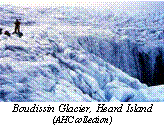 Permanent snow and ice cover 80% of Heard Island. Its
steepness combines with very high snow fall at high altitudes to
make the glaciers fast-flowing-in the order of 250 m a year-thus
the ice and snow in the glaciers has a relatively short turnover
period, around 100 years, and the glaciers respond quickly to
changes in climate by advancing or retreating.
Permanent snow and ice cover 80% of Heard Island. Its
steepness combines with very high snow fall at high altitudes to
make the glaciers fast-flowing-in the order of 250 m a year-thus
the ice and snow in the glaciers has a relatively short turnover
period, around 100 years, and the glaciers respond quickly to
changes in climate by advancing or retreating.
The glaciers of Heard Island provide an invaluable proxy record of climate change in this remote area, for which there are few instrumental records.
HIMI is the only sub-Antarctic island group that has an
intact ecosystem. It is the only sub-Antarctic island group to
contain no known species introduced directly by humans, which
makes it invaluable for having, within one site, an intact set
of interrelated ecosystems; terrestrial, freshwater, coastal and
marine, in which the ongoing evolution of plants and animals
occur in a natural state.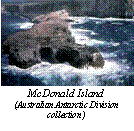
Heard Island's unmodified status and simple ecosystems make it an outstanding location for monitoring plant colonisation. HIMI is unequalled by any other islands in the sub-Antarctic region in this respect.
The islands host a range of seabirds. The extreme isolation
and the lack of introduced predators provide an excellent
location for investigating the effects of geographic isolation
and climate on the evolution of species. Active speciation is
clearly present. For example, the Heard shag Phalacrocorax
nivalis is found nowhere else but on Heard Island. The beetle
populations on HIMI show unique evolutionary adaptations to the
environment and several other invertebrate groups provide
valuable opportunities to study evolutionary processes in
undisturbed populations at the southern limits of their
distribution.
The seal and penguin populations provide excellent opportunities to monitor the health and stability of the larger Southern Ocean ecosystem. HIMI is one of the best sites in the world to study the ecological and biological processes of recolonisation of the Antarctic fur seal and the king penguin populations. It is also one of the best land-based sites in the world to study the leopard seal and its role in the sub-Antarctic ecosystem.
Further information
Contact details:
Australian Antarctic Division
Channel Highway
KINGSTON TAS 7050
AUSTRALIA
From the Department of the Environment and Heritage web site
Map of the Heard and McDonald Islands
|
This site is © Copyright Phil Greenwood 2009, All Rights Reserved. |
